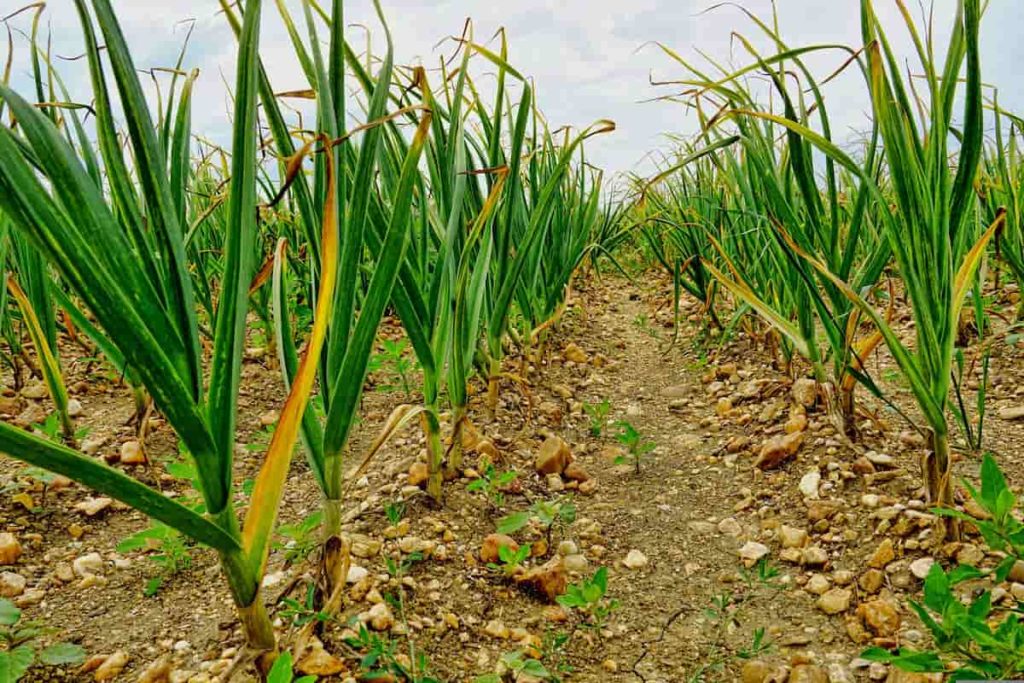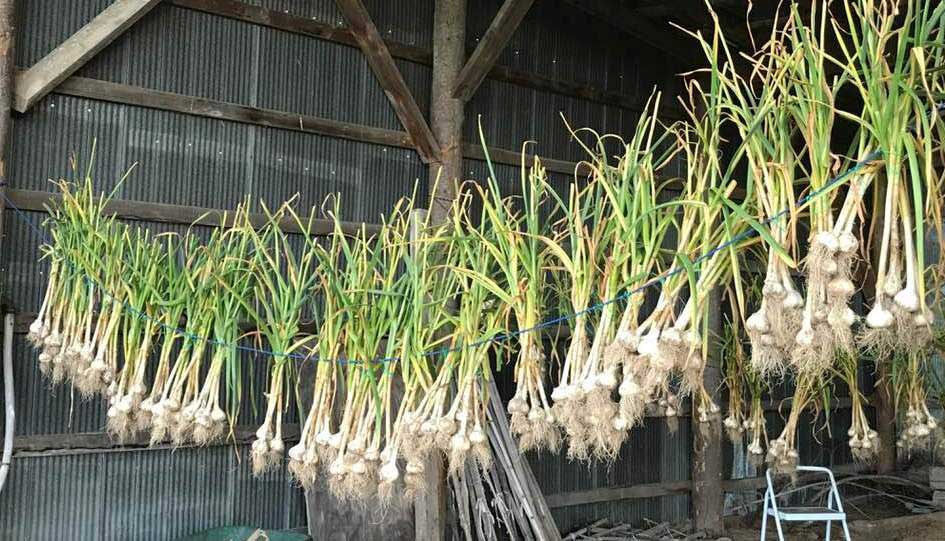प्याज की खेती एक महत्वपूर्ण कृषि प्रक� ...
Garlic is a widely used spice and medicinal plant cultivated for centuries. It is known for its spicy flavor, numerous health benefits, and versatile use in cooking. Successful garlic farming requires proper knowledge of soil conditions, planting methods, irrigation, and harvesting techniques. This guide covers the essential aspects of garlic farming for better yield and quality produce.
लहसुन की खेती एक लाभकारी कृषि व्यवसाय है, जिसे कम समय और खर्च में अच्छे मुनाफे के लिए किया जा सकता है। लहसुन को ठंडी जलवायु और उपजाऊ, जल-निष्काषित मिट्टी में उगाया जाता है। इसकी बुवाई अक्टूबर से नवंबर के बीच की जाती है, और फसल 4-5 महीने में तैयार हो जाती है। लहसुन में औषधीय गुण होते हैं, जिससे इसकी बाजार में भारी मांग रहती है। उचित सिंचाई, उर्वरक प्रबंधन और समय पर कीट नियंत्रण से लहसुन की अच्छी पैदावार ली जा सकती है।
लहसुन, जिसे आमतौर पर भारतीय रसोई में स्वाद बढ़ाने और स्वास्थ्य लाभ के लिए उपयोग किया जाता है, एक महत्वपूर्ण मसाला फसल है। इसकी खेती करने से न केवल किसानों को अच्छा मुनाफा होता है, बल्कि यह फसल मिट्टी की उर्वरकता को भी सुधारती है। इस लेख में हम लहसुन की खेती से संबंधित सभी महत्वपूर्ण पहलुओं पर विस्तार से चर्चा करेंगे।
लहसुन की कई किस्में होती हैं, जो उनकी रंगत और स्वाद के आधार पर भिन्न होती हैं। प्रमुख किस्में हैं:
1. पुसा कंदा
2. लहसुन 2
3. रोसालिया
4. बॉयलर
5. बदमाश
प्रत्येक किस्म की अपनी विशेषताएँ होती हैं जैसे कि ,u>उपज, आकार और स्वाद। सही किस्म का चयन मिट्टी और जलवायु की स्थिति पर निर्भर करता है।

लहसुन की खेती के लिए अच्छी तरह से सूखी और उपजाऊ मिट्टी सबसे उपयुक्त होती है। मिट्टी की pH 6.0 से 7.5 के बीच होनी चाहिए। लहसुन ठंडी जलवायु में अच्छी तरह से उगता है, और इसके लिए 15°C से 25°C तापमान आदर्श होता है। अत्यधिक गर्मी या ठंड से लहसुन की गुणवत्ता प्रभावित हो सकती है।
लहसुन की खेती के लिए भूमि की अच्छी तरह से तैयारी करना आवश्यक है। खेत को गहरी जुताई करके उसे ढीला करें और 15-20 टन प्रति हेक्टेयर की दर से गोबर की खाद मिलाएँ। इसके बाद, खेत को समतल बनाएं और अगर आवश्यक हो तो पानी लगाकर मिट्टी को तैयार करें।
लहसुन को सबसे अच्छे परिणाम के लिए अच्छे गुणवत्ता वाले कलियों का उपयोग करें। कलियों को बुआई के समय से 2-3 सेंटीमीटर की गहराई में बोना चाहिए। पौधों के बीच 15-20 सेंटीमीटर की दूरी रखें और पंक्तियों के बीच 30-40 सेंटीमीटर की दूरी रखें।
यह भी पढ़ें: गाजर की खेती | पत्तागोभी की खेती
लहसुन को नियमित सिंचाई की आवश्यकता होती है, खासकर प्रारंभिक विकास के चरण में। एक बार सिंचाई के बाद, हर 7-10 दिनों में पानी दें। उर्वरक के रूप में, 50 किलोग्राम नाइट्रोजन, 25 किलोग्राम फास्फोरस, और 25 किलोग्राम पोटेशियम प्रति हेक्टेयर की मात्रा लगाएँ। गोबर की खाद भी मिट्टी की उर्वरकता बढ़ाने में सहायक होती है।
लहसुन की फसल में आमतौर पर कीट जैसे की लहसुन की मक्खी और रोग जैसे की सफेद कवक हो सकते हैं। इनकी रोकथाम के लिए जैविक कीटनाशकों का उपयोग और फसल की नियमित निगरानी करना आवश्यक है। प्रभावित पौधों को तुरंत हटाकर कीटनाशक का छिड़काव करें।
लहसुन की फसल तब कटाई के लिए तैयार होती है जब पत्तियाँ पीली और सूखी हो जाती हैं। आमतौर पर, यह 150-180 दिनों के भीतर होता है। कटाई के बाद, लहसुन की कलियों को छाया में सुखाना चाहिए ताकि वे अच्छी तरह से सूख सकें और दीर्घकालिक भंडारण के लिए तैयार हो सकें।

लहसुन की खेती किसानों के लिए लाभकारी हो सकती है यदि सही तकनीकों का पालन किया जाए। मिट्टी की तैयारी, बीज बोने का समय, सिंचाई, उर्वरक प्रबंधन, और कीट नियंत्रण पर ध्यान देकर आप उच्च गुणवत्ता वाली फसल प्राप्त कर सकते हैं। यह फसल न केवल आर्थिक रूप से फायदेमंद है, बल्कि मिट्टी की उर्वरकता भी बढ़ाती है।
यह भी देखे -
Youtube video 📷- लहसुन की खेती
Garlic is a widely used spice and medicinal plant that has been cultivated for centuries. It is known for its pungent flavor, numerous health benefits, and versatile use in cooking. Successful garlic farming requires proper knowledge of soil conditions, planting methods, irrigation, and harvesting techniques. This guide covers the essential aspects of garlic farming for better yield and quality produce.
There are two main types of garlic: softneck and hardneck. Softneck garlic varieties are most commonly grown in warmer climates and have a longer shelf life, while hardneck varieties perform well in cooler climates. Popular varieties include:
1. California Early
2. California Late
3. Creole
4. Porcelain
5. Purple Stripe
Garlic grows best in well-drained loamy soil that is rich in organic matter. The ideal soil pH for garlic farming ranges from 6.0 to 7.0. It requires a cool, moist growing season and dry conditions for bulb maturation. Temperatures between 12°C to 24°C are optimal for good growth. Excessive rainfall or waterlogging can result in poor bulb development and diseases.
Proper land preparation is essential for garlic farming. The soil should be tilled to a fine texture, and well-decomposed organic manure should be applied at a rate of 15-20 tons per hectare to improve soil fertility. Raised beds or ridges can be used to ensure good drainage, which is crucial for garlic's root development.
Garlic is propagated from cloves, which are the individual segments of the garlic bulb. Cloves should be planted 2-3 cm deep, with the pointed end facing upward. Spacing is important; maintain a distance of 10-15 cm between cloves and 20-30 cm between rows. The best time for planting garlic is during the cool months, typically in October to November.
Garlic requires consistent moisture for proper growth, especially during the early stages. However, over-watering should be avoided as it can lead to bulb rot. Irrigate immediately after planting and continue regular watering throughout the growing season. Reduce irrigation as the bulbs mature, especially when the tops begin to dry, to promote proper curing of the garlic bulbs.
A balanced fertilization schedule is important for garlic farming. Apply 80 kg of nitrogen, 40 kg of phosphorus, and 40 kg of potassium per hectare. Half of the nitrogen and the full dose of phosphorus and potassium should be applied at the time of planting. The remaining nitrogen can be top-dressed during the growth stages for healthy plant development.
Garlic is relatively resistant to pests and diseases, but it can be affected by issues such as white rot, downy mildew, and nematodes. To prevent these problems, practice crop rotation, use disease-free planting material, and apply organic or chemical fungicides when necessary. Timely weeding is also important to avoid competition for nutrients and moisture.
Weeds can compete with garlic for nutrients, light, and water, leading to reduced yield. Manual weeding or the use of herbicides can help manage weeds in garlic fields. Mulching is another effective method to suppress weed growth while retaining soil moisture and regulating soil temperature.
Garlic is ready for harvest when the lower leaves turn yellow and begin to dry. This typically occurs 90-120 days after planting, depending on the variety and growing conditions. After harvesting, bulbs should be cured by drying them in a well-ventilated area for 2-3 weeks. Proper curing enhances storage life and reduces the risk of spoilage. Store garlic in a cool, dry place with good air circulation to prevent sprouting or rotting.
Garlic farming can be highly profitable with the right approach. By selecting the appropriate variety, ensuring good soil conditions, following proper planting techniques, and managing irrigation, pests, and weeds effectively, farmers can achieve high-quality yields. Garlic is in constant demand in both domestic and international markets, making it a valuable crop for farmers looking to diversify their agricultural portfolio.
0
0
प्याज की खेती एक महत्वपूर्ण कृषि प्रक� ...
Potatoes are a versatile and widely consumed root vegetable, rich in nutrients such as carbohydrates ...
Coriander farming offers lucrative returns for farmers due to its high demand in the culinary and me ...
September is an ideal month for sowing various vegetables that can be harvested in the cooler months ...
Ghiya, also known as bottle gourd, is a popular and nutritious vegetable grown in many parts of Indi ...
Tomato farming is a popular agricultural practice due to the high demand for tomatoes worldwide. It ...
खीरा की खेती एक लाभदायक कृषि व्यवसाय ह ...
अक्टूबर का महीना शरद ऋतु का प्रारंभ हो ...
Beetroot cultivation is a profitable agricultural venture that involves growing a nutritious root ve ...
Tauri, also known as Ridge Gourd, is a popular vegetable cultivated in many parts of Asia. It is hig ...
Eggplant, also known as Brinjal or Solanum melongena, is a widely cultivated vegetable in India, pri ...
Pea (Pisum sativum) is one of the major legume crops in India, used both as a vegetable and a pulse. ...
Chickpea (Cicer arietinum) is an important pulse crop, particularly grown in India. Its cultivation ...
Sem, also known as ‘Beans,’ is a significant leguminous crop that is not only rich in nutrition ...
Bathua (Chenopodium album) is a nutritious leafy vegetable commonly grown during the winter season i ...
Lentils (Lens culinaris) are a valuable pulse crop grown in India during the Rabi season. Known for ...
The winter season is an excellent time for farmers, especially for cultivating vegetables. Vegetable ...
After harvesting rice, it is important for farmers to plan for the next crop. This is the time when ...
December marks the beginning of winter, making it an ideal time for vegetable farming. This season p ...
Red spinach, known as "लाल साग" in Hindi, is a nutrient-rich leafy vegetable that stands ...
There’s something special about enjoying freshly grown vegetables from your own home. It’s not o ...
February is an important time for agriculture, especially for farmers who are preparing for rabi and ...
Fruit drop or lack of fruiting in bottle gourd plants is a common issue, whether they are grown in s ...